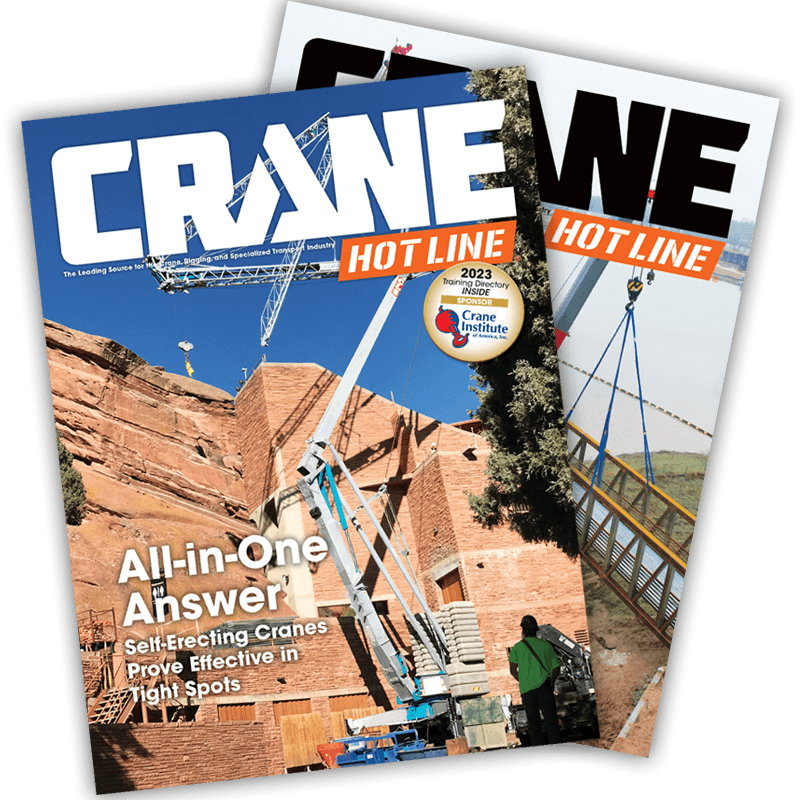Guest Column: The Top 10 Most-Damaged Rigging Products, and How to Keep them Protected
I’ve been fortunate to have been part of this terrific industry for many years, and during my tenure, I have worn many hats. From rental rigging salesperson and customer trainer to corporate trainer and manager, each has taught me something about rigging. However, the one job that has been the most satisfying is being a corporate trainer. Walking through our warehouses and witnessing the damage done to our equipment by customers is disappointing and alarming. For me, it represents the increased likelihood of someone hurting themselves or others or damaging property, and then there is the ever-present concern of a fatality.
As corporate trainer, it allows me to share my experience and expertise, but more importantly, my mistakes. Internally, I have developed a class for our representatives that teaches some of these mistakes and how to troubleshoot them, so they can train our customers. This task, albeit daunting, falls under the adage of how to eat an elephant (one bite at a time). Just like our customers and all of you, I have made many mistakes.
The good news is that, in general, you do not learn from your successes, only your failures, or in this case, our customers’ failures. I would like to share with you Lifting Gear Hire’s top 10 rental products that get damaged and why.
1. Hooks and Safety Latches: Having to replace thousands of hooks on our hand, electric and air-powered chain hoists and come-a-longs, we have seen it all and have a large stock room for replacements. The most common ways hooks and safety latches become damaged are through point-loading or twisting so they can used to form a choker hitch. Although safety latches are fairly inexpensive, time and again, we see hooks come back with twisted and deformed safety latches. Some even come back with the latch completely removed. Forming a choker with the hook destroys the latch, and sometimes it is removed intentionally to make way for the over-sized hardware that will join to the hook.
2. Air caster bladders: Air casters/skates are handy tools, but they are very misunderstood. In lieu of machine skates or pipe rollers, the air casters can move equipment around on a thin layer of air, similar to that of a hover craft or air hockey table. When used correctly, they decrease the coefficient of friction to below 1%. The challenges arise when users are not familiar with the equipment, and they are not willing to properly prepare the floor surface to ensure they have the proper air requirements for a successful move. I have walked many jobs with customers who want to use air casters, but based on their unwillingness to properly prepare the floor, I have made the suggestion that they do not use the casters. If your air isn’t sufficient combined with poor surface quality, then it becomes increasingly likely that you will damage the bladder—a key component of the casters. This will result in a very expensive repair bill.
3. Roust-a-Bouts, Tee Head Masts and Shear Pins: These items are essential on most commercial and industrial projects where pipes are hoisted and placed within hangers. The two most common parts that need to be replaced are the top tee head masts and shear pins. Both are somewhat related. The top of the masts can be become damaged for several reasons, such as overloading without having the proper guy lines attached. If the hand crank winches are not properly used, it will result in the same damage, as well. The shear pin is an overload protection device that go to work not too long after the rated capacity is exceeded. With workers standing so close to these heavy loads, it’s unsettling how many times we have to replace these parts.
4. Tank rollers: These get their name because they literally look like little tanks. Made of steel, they’re also tough as tanks. Unless of course, you perform a couple of unsafe practices. Too often, when making a turn while equipment is resting on top of them, workers elect not to use a jack to alleviate the weight from the roller before re-orienting it. Instead they will use a heavy hammer to do all of the turning. Tired of leaving the fourth corner skate behind? Doing what others have done in the past will surely hit the project’s budget. One of the most time-saving fixes is to quickly weld the rollers to the unit, ensuring all skates are attached throughout the move. Avoiding the mistakes will maintain the intended level of safety and save on repairs.
5. Electric Power Bars: Although this item can help save your back and prevent hernia surgery, it is often unnecessarily damaged. It provides high torque power to skid or push a load that is on a helper, like air skates or tank rollers. Too often, it is used beyond its rated capacity of about 8,000 lbs., and a couple of internal overload protection components, spur gear, and electric motor cluster, which are designed to protect the motor, will do their job. In addition, some inexperienced customers have placed the load directly on top of the unit on the embossed plate stating “WARNING: Tongue Load Only. Do not load this surface.” Lastly, it can be easy to damage the unit by not coming to a complete stop and reversing the equipment while it is still moving forward.
6. Modular spreader beams: Our modular spreader beams work by means of compressive forces moving from the ends toward the center of the beam. The next time you want to add any rigging other than the specified top or bottom shackles, come by to see a normally straight strut piece that has been reshaped into a taco. The common issue for most pieces of equipment is that many do not take the time to educate themselves by reading the use and care manual. I get it; I did not read my weed wacker manual until it was time to replace the feed line. However, when lifting upwards of 900 tons, this is one manual to pick up and comprehend. Again, with these beams, you cannot attach rigging or have rigging even resting against any part of the beam accept where permissible, on the end unit shackles.
7. Hydraulic cylinders with threaded collars: Another piece of equipment that raises my hairs is damage to the collar threads of a lock-nut hydraulic cylinder. One of the most heard phrases by my students from me is “plumb and level.” This transcends many different applications and projects in life, but especially with high-tonnage tools. When used properly and effectively, and set on firm level surfaces capable of withstanding whatever the forces that are being jacked, this equipment is vital to maintaining and constructing power stations, petrochemical facilities, our infrastructure systems and much more. The specific plungers of these cylinders are manufactured as one piece with threads on the outside that accommodates a nut that can lock the cylinder in place for longer lasting applications. Unfortunately, when the cylinder is side loaded, a tremendous amount of force is applied to the threads. As it retracts against the outer-housing, the threads become sheared, resulting in a piece of equipment that cannot be repaired.
8. Hydraulic gantries: You wouldn’t build a house on dirt and without solid footings. The same can be said about hydraulic gantries. An elevated track is recommended for use with gantries. By using shims, you can create a solid, level, and plumb foundation for which to set the gantries. Too many times, gantries are used without a solid foundation. When you are hoisting up near 20 tons and both vertical staging plungers are out of plumb, you are inviting a catastrophe. Thankfully, we have been fortunate that there have not been significant accidents while these have been used. However, because of the misuse and side loading of the plungers, critical seals are often damaged, resulting in a hefty repair bill.
9. Wire Rope and Polyester Slings: Wire rope slings and their polyester counter parts are treated like red-headed step children, at times. The need for ongoing training is essential to perform at the highest degree of safety. When combined with a similar culture, leadership, and commitment, this gets further solidified. Unfortunately, slings are stored incorrectly, wrapped around tight, sharp corners, have loads abruptly set upon them, and undergo many more misuses. Basic knowledge of hitches, D/d ratios, and load angle factors can go a long way in preserving these items. Our polyester slings come back with outer sleeve damage frequently. And almost daily, we see slings coming back that have both sleeves torn, rendering them unusable. The key here is finding quality resources to educate you and your team on the proper ways to use these items and the cautions and warnings as to how to not use them.
10. Brakes on Pneumatic Winches and Hoists: Closing out list are some of the more important tools on projects. We all know that since we having been driving at the age of 15, err 16, that riding the brake will quickly deteriorate its effectiveness. The same is true for air-operated hoists and winches. One of the built-in safety components of these tools is you need to apply the proper amount of PSI for the brake to disengage. Meaning, if your air source suddenly loses pressure, your load and everything around it is still safe and secure. However, if the quality of air does not meet the specified requirements of the tool, you will likely be diminishing the brakes because they have not been fully disengaged. On the contrary, having too much PSI will hinder the brake from engaging when you want to stop. This will look as if the load is drifting and has caused many a contractor to have to change their shorts before resuming work. In that case, a simple pressure regulator can assist. You may also want to invest in an air flow meter that attaches between the supply hose, but directly to the equipment. This provides a window into the system and will show the PSI versus flow, so you can determine your next steps, which may be getting a larger compressor to power the tools. We talk frequently about helping our contactors succeed with the equipment. Reviewing the proper air requirements of PSI and SCFM well before the project begins is one of the most important conversations we have. It confirms all parties have a full understanding of the proper air required, and will expose other important factors. Such as, using plant-produced air during maintenance outages will likely cause pressure and flow drops. Insuring that the user is willing to properly plan for smooth operations to keep up production is a simple, but is usually missed in the planning process.
If you have gotten this far, congratulations. You are committed to increasing your own safety knowledge and saving some money along the way. I wish this list did not cover so many important components of the equipment, but if we continue to learn from each another, while removing some of the unsafe practices of “we’ve just always done it that way,” we will make this an even better industry for which we play a major play a role.


